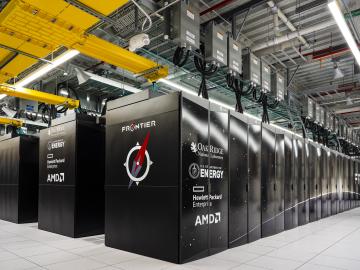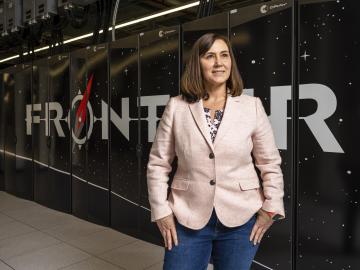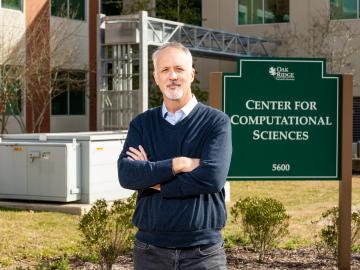
Filter News
Area of Research
- (-) Advanced Manufacturing (8)
- (-) Biology and Environment (69)
- (-) Supercomputing (92)
- Biology and Soft Matter (1)
- Building Technologies (2)
- Computational Biology (1)
- Computational Engineering (2)
- Computer Science (8)
- Electricity and Smart Grid (1)
- Energy Science (98)
- Energy Sciences (1)
- Fuel Cycle Science and Technology (1)
- Functional Materials for Energy (1)
- Fusion and Fission (31)
- Fusion Energy (13)
- Isotope Development and Production (1)
- Isotopes (5)
- Materials (43)
- Materials for Computing (5)
- Mathematics (1)
- National Security (27)
- Neutron Science (14)
- Nuclear Science and Technology (41)
- Nuclear Systems Modeling, Simulation and Validation (2)
- Quantum information Science (1)
- Sensors and Controls (1)
News Topics
- (-) Advanced Reactors (3)
- (-) Artificial Intelligence (42)
- (-) Exascale Computing (28)
- (-) Frontier (32)
- (-) Molten Salt (1)
- (-) Nuclear Energy (6)
- (-) Security (6)
- 3-D Printing/Advanced Manufacturing (33)
- Big Data (29)
- Bioenergy (50)
- Biology (76)
- Biomedical (28)
- Biotechnology (15)
- Buildings (6)
- Chemical Sciences (15)
- Clean Water (11)
- Composites (8)
- Computer Science (105)
- Coronavirus (22)
- Critical Materials (4)
- Cybersecurity (9)
- Energy Storage (11)
- Environment (105)
- Fusion (3)
- Grid (7)
- High-Performance Computing (56)
- Hydropower (8)
- Isotopes (3)
- Machine Learning (21)
- Materials (29)
- Materials Science (27)
- Mathematics (5)
- Mercury (7)
- Microscopy (16)
- Nanotechnology (16)
- National Security (9)
- Neutron Science (18)
- Partnerships (6)
- Physics (9)
- Polymers (4)
- Quantum Computing (20)
- Quantum Science (25)
- Simulation (26)
- Software (1)
- Space Exploration (4)
- Summit (47)
- Transportation (8)
Media Contacts

With the world’s first exascale supercomputer now fully open for scientific business, researchers can thank the early users who helped get the machine up to speed.

Oak Ridge National Laboratory researchers recently demonstrated use of a laser-based analytical method to accelerate understanding of critical plant and soil properties that affect bioenergy plant growth and soil carbon storage.

To support the development of a revolutionary new open fan engine architecture for the future of flight, GE Aerospace has run simulations using the world’s fastest supercomputer capable of crunching data in excess of exascale speed, or more than a quintillion calculations per second.

Simulations performed on the Summit supercomputer at ORNL revealed new insights into the role of turbulence in mixing fluids and could open new possibilities for projecting climate change and studying fluid dynamics.

Innovations in artificial intelligence are rapidly shaping our world, from virtual assistants and chatbots to self-driving cars and automated manufacturing.

Lawrence Livermore National Laboratory’s Lori Diachin will take over as director of the Department of Energy’s Exascale Computing Project on June 1, guiding the successful, multi-institutional high-performance computing effort through its final stages.

A study led by researchers at ORNL could uncover new ways to produce more powerful, longer-lasting batteries and memory devices.

At the National Center for Computational Sciences, Ashley Barker enjoys one of the least complicated–sounding job titles at ORNL: section head of operations. But within that seemingly ordinary designation lurks a multitude of demanding roles as she oversees the complete user experience for NCCS computer systems.

The Oak Ridge Leadership Computing Facility’s Matt Sieger has been named the project director for the OLCF-6 effort. This next OLCF undertaking will plan and build a world-class successor to the OLCF’s still-new exascale system, Frontier.

Nature-based solutions are an effective tool to combat climate change triggered by rising carbon emissions, whether it’s by clearing the skies with bio-based aviation fuels or boosting natural carbon sinks.


